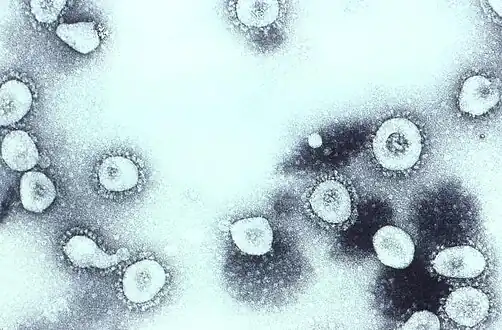Betacoronavirus 1
| Betacoronavirus 1 | |
|---|---|
 | |
| Transmission electron micrograph of human coronavirus OC43 | |
| Virus classification | |
| (unranked): | Virus |
| Realm: | Riboviria |
| Kingdom: | Orthornavirae |
| Phylum: | Pisuviricota |
| Class: | Pisoniviricetes |
| Order: | Nidovirales |
| Family: | Coronaviridae |
| Genus: | Betacoronavirus |
| Subgenus: | Embecovirus |
| Species: | Betacoronavirus 1 |
| Member viruses[1] | |
| |
| Synonyms | |
Betacoronavirus 1 is a species of coronavirus which infects humans and cattle.[4][5] The infecting virus is an enveloped, positive-sense, single-stranded RNA virus and is a member of the genus Betacoronavirus and subgenus Embecovirus.[6] Like other embecoviruses, it has an additional shorter spike-like surface protein called hemagglutinin esterase (HE) as well as the larger coronavirus spike protein.[7][8]
References
- ↑ de Groot, R.J; et al. (2009). "ICTV 9th Report (2011) New Coronaviridae". International Committee on Taxonomy of Viruses (ICTV). Archived from the original on 23 January 2020. Retrieved 23 January 2020.
- 1 2 3 4 5 6 de Groot, Raoul J.; et al. (2009). "Revision of the family Coronaviridae" (PDF). International Committee on Taxonomy of Viruses (ICTV). p. 18. Archived (PDF) from the original on 7 February 2019. Retrieved 23 January 2020.
A new species, Betacoronavirus 1, is proposed to accommodate previously established Betacoronavirus species of humans, cattle, swine and horses (Human enteric coronavirus; Human coronavirus OC43; Bovine coronavirus; Porcine hemagglutinating encephalomyelitis virus; Equine coronavirus) and a newly recognized virus of dogs (canine respiratory coronavirus; Erles et al., 2007)
- ↑ ICTV 5th Report Francki, R. I. B., Fauquet, C. M., Knudson, D. L. & Brown, F. (eds)(1991). Classification and nomenclature of viruses. Fifthreport of the International Committee on Taxonomy of Viruses. Archives of Virology Supplementum 2, 452 pp. https://talk.ictvonline.org/ictv/proposals/ICTV%205th%20Report.pdf Archived 2020-01-23 at the Wayback Machine
- ↑ "Virus Taxonomy: 2018b Release" (html). International Committee on Taxonomy of Viruses (ICTV). March 2019. Archived from the original on 4 March 2018. Retrieved 23 January 2020.
- ↑ Lim, Yvonne Xinyi; Ng, Yan Ling; Tam, James P.; Liu, Ding Xiang (2016-07-25). "Human Coronaviruses: A Review of Virus–Host Interactions". Diseases. 4 (3): 26. doi:10.3390/diseases4030026. ISSN 2079-9721. PMC 5456285. PMID 28933406.
See Table 1.
- ↑ "Taxonomy browser (Betacoronavirus 1)". www.ncbi.nlm.nih.gov. Retrieved 2020-02-29.
- ↑ Woo, Patrick C. Y.; Huang, Yi; Lau, Susanna K. P.; Yuen, Kwok-Yung (2010-08-24). "Coronavirus Genomics and Bioinformatics Analysis". Viruses. 2 (8): 1804–1820. doi:10.3390/v2081803. ISSN 1999-4915. PMC 3185738. PMID 21994708.
In all members of Betacoronavirus subgroup A, a haemagglutinin esterase (HE) gene, which encodes a glycoprotein with neuraminate O-acetyl-esterase activity and the active site FGDS, is present downstream to ORF1ab and upstream to S gene (Figure 1).
- ↑ Woo, Patrick C. Y.; Huang, Yi; Lau, Susanna K. P.; Yuen, Kwok-Yung (2010-08-24). "Coronavirus Genomics and Bioinformatics Analysis". Viruses. 2 (8): 1804–1820. doi:10.3390/v2081803. ISSN 1999-4915. PMC 3185738. PMID 21994708.
The presence of HE genes exclusively in members of Betacoronavirus subgroup A, but not members of Betacoronavirus subgroup B, C and D suggested that the recombination had probably occurred in the ancestor of members of Betacoronavirus subgroup A, after diverging from the ancestor of other subgroups of Betacoronavirus.
This article is issued from Offline. The text is licensed under Creative Commons - Attribution - Sharealike. Additional terms may apply for the media files.